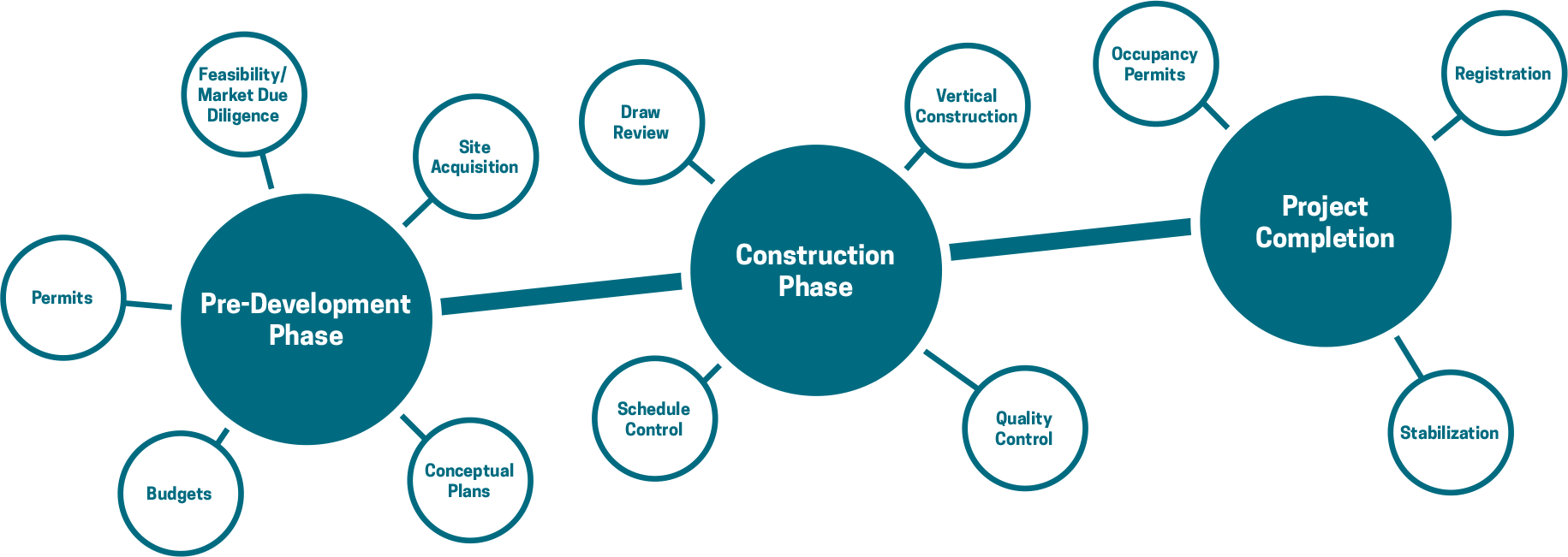Becoming a property developer, or even dabbling in the idea of development is not as simple as it seems. Any project requires extensive legwork and preparation, well before the first shovel is in the ground. The majority of time is spent in the pre-development stage; working through market and feasibility studies, design and planning, approvals, documentation and financing. Less than 50% of a project’s duration is the visible on site construction period.
Developing any real estate project is a complex process which you can be brake down into 3 typical stages: pre-development, construction, and project completion. Below you will see a brief description of each stage and some of the steps within each stage.

Pre-Development
After you have completed your market research, determined the demand for your project, and found a potential site. The next step is to come up with a concept plan. What can you currently build on the site? What can you potential build on the site? How many units? How big? What restrictions are there?
In the early stages of a project, you mainly focus on due diligence, research, planning, and permitting. Investing at this stage carries the greatest and most varied risks; because there are many unknowns you must first assess, the local community plans, bylaws, development and planning policies. All of these documents are freely accessible on the municipal web site, or alternatively you can visit their offices and ask to see a hard copy in the planning department.
Some of the common steps in this phase include:
- Market analysis and feasibility studies
- Securing a potential site
- Environmental assessments and Surveys
- Concept Plans
- Land or property acquisition
- Site plans, development plans, and building plans
- Permitting
- Some infrastructure improvements (horizontal servicing)
- Arranging construction financing
- Branding & Marketing
Construction
The middle stage involves construction and improvements. Since the pre-development tasks have been completed, the project risks at this stage are greatly reduced but certainly not eliminated.
Finally you get on site and start building your project, although this stage can last anywhere between six and twelve months, depending on the size of the project, it’s the most exciting aspect of the development as you see all of your hard work coming to fruition.
Some of the common steps in this stage include:
- Vertical construction
- Project marketing
- Draw review on construction financing
- Pre-Sales and/or Leasing
- Schedule Control
- Quality Control
- Project Accounting
- Contractor Payment auditing
- Arranging permanent financing (if not arranged during pre-development)
- Arranging for property manager (if not arranged during pre-development)
Project Completion
The final stage of the development process is project completion, and in other words, this is the first stage of the building’s life. While the pre-development and construction risks may be removed by this point, selling the property, or obtaining tenants is still a risk.
The occupancy permit generally marks the end of the construction phase and allows for the commencement of completion stage. As with the building permit, it is based upon objective criteria regarding construction quality and is a fairly administrative process.
Some activities during the final stage include:
- Ongoing marketing
- Finding a buyer, if not done earlier
- Determining a hold strategy, if not selling
- Ramping up property management
- Construction completion
- Document completion
- Title registration
- Closing of sales
- Move-in day
- Achieving stabilization
Need more information? Contact us.
North Saanich, BC V8L 5W5

